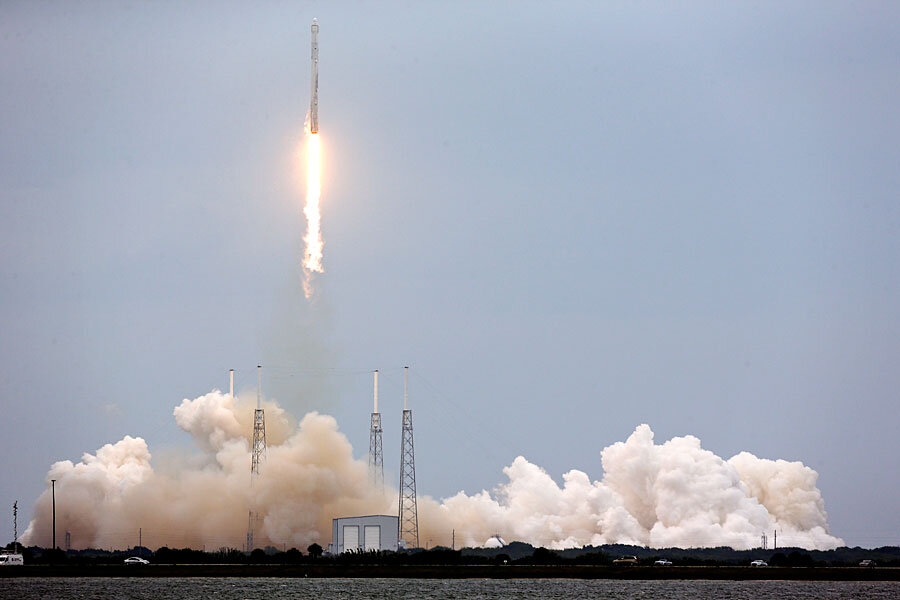SpaceX achieves a first: bringing booster to soft landing on Earth
Loading...
Space Exploration Technologies Corp. (SpaceX) has become the first rocket-maker to launch a liquid-fueled booster into space and bring it to a soft landing on Earth, although in this case, the landing spot was the Atlantic Ocean.
The landing system's first operational test occurred as part of the company's third space-station resupply mission, which launched April 18 from the US Air Force's Cape Canaveral station. The mission's Dragon cargo capsule arrived at the International Space Station on Easter Sunday.
The first hints that the system worked as designed came several hours after the launch, when SpaceX CEO and chief designer Elon Musk announced via Twitter that the test was successful.
During a press conference Friday, he described the touchdown, based on telemetry readings from multiple sensors that the booster radioed back through its descent and for eight seconds after touchdown.
"The data is very clear. It shows a soft landing, it shows deployment of all the legs," it came down vertically, and the booster stage, with its nine main engines, was in a safe state in the water, he said.
The touchdown was all the more remarkable because it took place during a storm. Indeed, with seas running 15 to 20 feet, the booster broke up soon after it landed. Seas were so rough that the SpaceX team had to wait two days before the boats that the company had hired could make the trip to the site.
By the time boats reached the site, the only debris left were some bits and pieces, including part of one of four legs that extend from the booster's body for landing, as well as a large carbon-fiber structure that joins the first and second stages of the company's Falcon 9 rocket.
The booster stage landed within a few miles of its targeted landing area. With successive launches, the team intends to shrink that to a one-mile radius – a goal necessary for initial landings back at Cape Canaveral. It's a feat that the company could attempt by the end of this year, if all goes well in the meantime, Mr. Musk said.
Still, "no one has ever soft-landed a liquid-[fueled] boost stage before," he said. "I think this bodes very well" for building a launch system that is fully reusable.
A fully reusable rocket, especially one that can be refueled and launched again quickly, is a key element to significantly reducing the cost of launching payloads and people into space. These two goals eluded the National Aeronautics and Space Administration's space shuttles.
For SpaceX, the booster stage represents about 70 percent of a rocket's cost, while fuel runs another 0.3 percent. If the booster returns to the launch site, in principle it could be refueled and ready for launch the same day, Musk said.
Yet aerospace specialists say that reusability alone won't necessarily reduce launch costs significantly unless the cost can be spread over many launches, and it's not clear if sufficient demand is out there. Part of the hope is that lower launch costs themselves will stimulate demand for launch services from research or commercial interests that were previously priced out of the market.
The economics aren't lost on SpaceX, which has filed suit in the US Court of Federal Claims in Washington to protest the Air Force's recent award of a 36-rocket contract to United Launch Alliance, a joint venture between Boeing and Lockheed Martin, to loft national-security payloads. The contract was inked without any opportunity for competitive bidding, Musk said.
SpaceX wants to capture some of that business. It has been working toward Air Force certification for its Falcon 9 rocket. The company didn't need to make any changes in its rocket to comply, Musk said. Instead, the process has largely been centered on paperwork. In any event, "we're most of the way through that process," he said.
In congressional hearings earlier this month, Air Force Gen. William Shelton, who heads the Air Force Space Command, told lawmakers that the Air Force made the move as the "most cost-effective way to go at launch capability."
United Launch Alliance, he explained, was the only launch provider capable of lofting the full array of national-security payloads and for now is the only certified launch provider. Buying in bulk would be more economical for the taxpayer than opening each launch to competition, he argued.
"SpaceX is coming along, and we'll have them certified, we're confident, in the not-too-distant future, but there's a lot of work to do before we get there," he said.
At Friday's press conference, Musk wondered aloud: "Since this is a large, multiyear contract, why not wait a few months for the certification process to complete, and then do the competition?"






